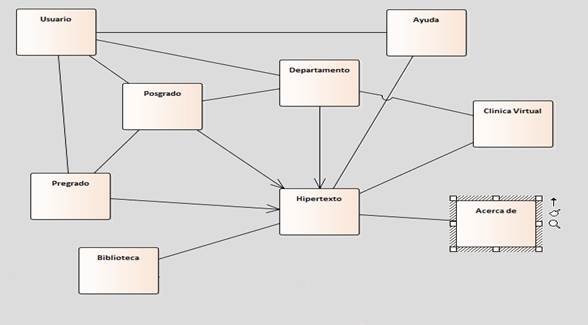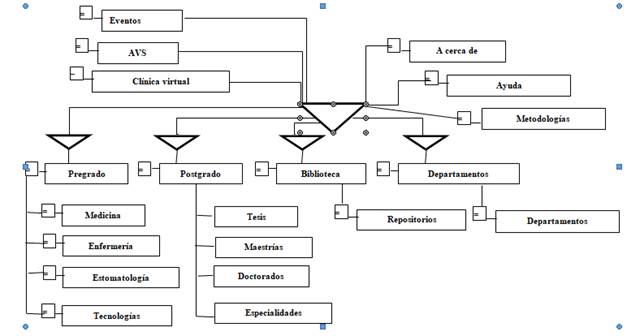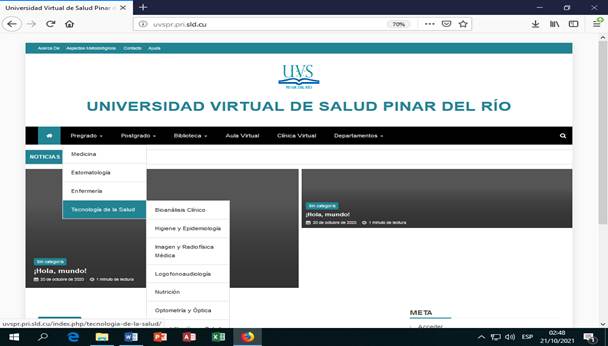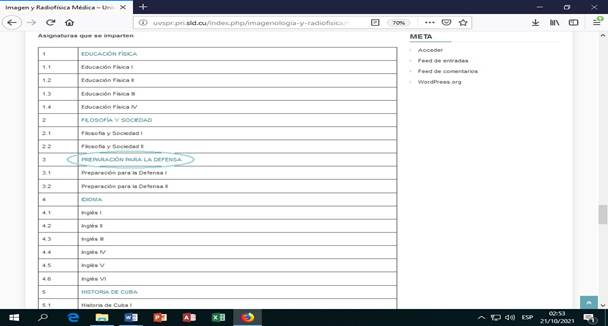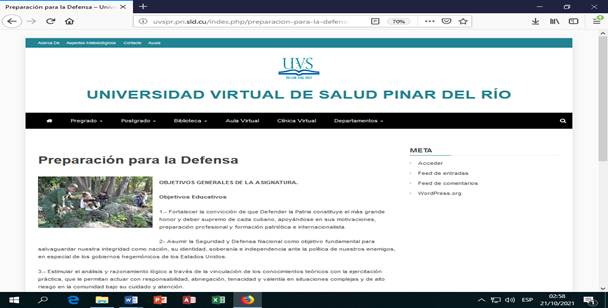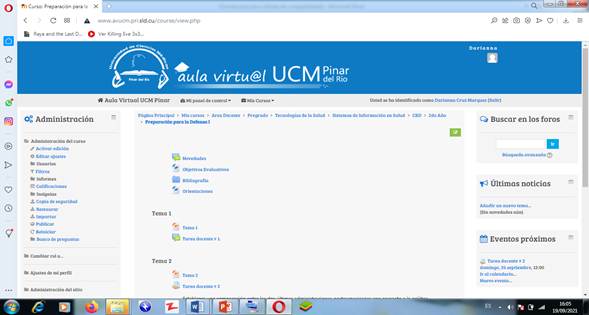Mi SciELO
Servicios Personalizados
Articulo
Indicadores
-
 Citado por SciELO
Citado por SciELO
Links relacionados
-
 Similares en
SciELO
Similares en
SciELO
Compartir
Revista de Ciencias Médicas de Pinar del Río
versión On-line ISSN 1561-3194
Rev Ciencias Médicas vol.27 no.3 Pinar del Río mayo.-jun. 2023 Epub 01-Mayo-2023
Articles
Web application for teaching the subject "Preparation for the Defense"
1University of Medical Sciences of Pinar del Río Dr. Ernesto "Che" Guevara de la Serna Faculty of Medical Sciences. Pinar del Rio, Cuba.
2University of Medical Sciences of Pinar del Río "Raúl Sánchez" University Teaching Polyclinic. Pinar del Rio, Cuba.
Introduction:
training in virtual environments constitutes one of the spearheads in many innovation proposals for current higher education. Learning objects, designed with their use, are probably the most important trend in the world regarding the production of educational contents as an additional support to the teaching-learning process.
Objective:
to develop a Web application for the teaching-learning process of the Defense Preparation discipline, in order to improve the quality of military preparation in the training of health professionals at the Dr. Ernesto "Ché" Guevara de la Serna School of Medical Sciences in Pinar del Rio.
Methods:
the research was based on the dialectical approach, which was assumed as the philosophical basis of the elements dealt with in the thesis, research methods were used, both theoretical and empirical, among which were: historical-logical, analysis and synthesis, induction and deduction, modeling and documentary analysis.
Results:
resources are visualized according to the careers where this discipline is studied, both undergraduate and graduate, through friendly and simple graphic interfaces.
Conclusions:
The development of this web application solves problems of resource, space and time limitations necessary to contribute to the quality of teaching and learning.
Key words: HIGHER EDUCATION; PROFESSIONAL TRAINING; DISTANCE EDUCATION.
INTRODUCTION
Information and communication technologies (ICTs) have become significant resources inherent to the development of significant resources inherent to the development of all spheres of life. Therefore, it is difficult to underestimate the central role that ICT have played in education today.1
Training in virtual environments through ICTs is one of the spearheads of many proposals for innovation in higher education today. Learning objects, designed with their use, are probably the most important trend in the world regarding the production of educational content as additional support to the teaching and learning process (PEA).2 In Cuba, the improvement of Higher Education is based on the need to train a professional capable of responding to the demands of the social demands of contemporary times, characterized by the uninterrupted development of ICTs.(3
In this sense, medical education faces an important set of changes in the development of its teaching and educational process for the training of its human resources with the process of universalization of education, and fundamentally related to the creation of new teaching scenarios, characterized by high enrollment rates, so that the incorporation of ICT is a challenge for teachers and students.(4
In the context of teaching scenarios, teaching aids are enriched and are generally grouped into direct perception media, still images, moving images, sound, real situation, simulation; and those supported by the use of ICTs: computers, educational software, telematic networks such as Infomed, which provide new forms and methods for transmitting knowledge.5
In this regard, in the last decade there have been numerous experiences of web-based learning. The use of web sites, whether institutional or thematic, and virtual and digital libraries, constitute an important support for users because they allow them to locate information quickly and access it regardless of the time and place where it is located.6 These facilities proposed by technology motivate its use to be exploited in the most efficient way to ensure access to reliable and timely information from updated, accredited and validated scientific research.
The way students learn is changing, and the University is facing the development of Web 2.0, considered as a source of learning. In the literature it is related to the concept of e-learning 2.0, where students use Web 2.0 media, social software, wikis, weblogs or RSS, in collaborative learning activities to autonomously produce their own content and use it for their learning objectives.
In Cuban Medical Education, research has been carried out in recent years, based on the development of Web 2.0 for the advantages it offers to students in their learning, among which the following stand out: Theoretical foundations of Web 2.0 for teaching in higher education,7 The teaching of the LibreOffice Calc application using virtual learning environments at the "Salvador Allende" Faculty of Medical Sciences,8 Computer system for the management of patients with HIV/AIDS at the Provincial Center of Hygiene Epidemiology and Microbiology of Guantanamo,9 Image gallery on the website of Medical Sciences of Sancti Spíritus.10
Researches such as: Design of the website of the Virtual Health University of Pinar del Río,11 Nefroweb: alternative for postgraduate professional improvement on Nephrogeriatrics,5 Computerization of the teaching literature lending service,12 Medical Microbiology and Parasitology Practice integrated to the Distance Laboratory System in the Medicine career,13 Interactive Web site for learning the morphophysiology of the muscular system; 14 are examples of the development of Web applications in medical education in the province of Pinar del Rio.
In the Faculty of Medical Sciences Dr. Ernesto "Ché" Guevara de la Serna of Pinar del Rio, there are several disciplines that in their methodological and organizational indications recommend the application of the latest pedagogical achievements in the use of information and communication technologies, such as distance education systems, the use of didactic television and others. One of these disciplines is Preparation for Defense, which is part of the curricula of Medical Science careers since the 1995/96 academic year, with objectives that respond to the model of the future professional, endorsed by Resolution No. 113 of August 12, 2002, signed by the Ministers of the Revolutionary Armed Forces (FAR) and Higher Education and Resolution No. 2 of May 2010 by the Minister of the FAR.15
In the observation made to the teaching-learning process of the Defense Preparation discipline in Medical Sciences careers, at the University of Medical Sciences of Pinar del Río, it was evidenced:
Limitations in the learning resources necessary for students to appropriate the knowledge and skills proposed in the study programs, the insufficient bibliography available to students for the study of the discipline with examples in order to their specialty. Students consider that the contents are somewhat tedious, complex, so that sometimes they are discarded, affecting the quality of research papers presented in scientific conferences. Taking into account these weaknesses, the following scientific problem is posed: What technological means should be used to improve the teaching and learning process of the discipline Preparation for Defense in Medical Sciences careers?
The General Objective is then defined as follows: to develop a Web application for the teaching-learning process of the Defense Preparedness discipline, in order to improve the quality of military preparation in the training of health professionals at the Dr. Ernesto "Ché" Guevara de la Serna School of Medical Sciences in Pinar del Rio.
METHODS
An applied research was carried out according to its character, descriptive according to the knowledge or level of knowledge to be obtained since phenomena are described, of technological innovation, for the final product to be obtained and with a general dialectical-materialist methodological approach in the discipline of Defense Preparedness, which is assumed as the philosophical basis of the elements treated in the thesis, allowing the selection of research methods, procedures and techniques, both theoretical, empirical and mathematical-statistical, based on the theory of Carlos Alvarez de Zayas (1996), which were used in the research process in order to meet the stated objective:
The methods used in this research were:
Theoretical Methods:
Historical-Logical: It made possible the study of the processes linked to the teaching of the discipline Preparation for Defense.
Induction-Deduction: This method allowed the capture of requirements, analysis, design of the web application.
Modeling: It was used to model the information up to the design of the web application.
Analysis and synthesis: It was applied throughout the research process to reach the multilateral knowledge of the teaching-learning process of the discipline Preparation for Defense, to delimit the essential elements that make it up, as well as the existing links between them and their most general characteristics.
Empirical methods:
Interview: employed to validate the requirements exposed by the client. These interviews were carried out with professors, tutors and students of the Dr. Ernesto "Ché" Guevara de la Serna School of Medical Sciences in Pinar del Rio.
Scientific observation: it was used in the verification of the scientific problem.
Documentary analysis: it allowed the study of the contents and means related to the teaching of the discipline.
RESULTS
For the development of the Web application, the elements associated with the design and elaboration are addressed, taking into account the Relationship Management Data Model (RMM) methodology.
First stage: representation of the domain objects through the Entity-Relationship model in Fig 1, extended with associative relationships; which are those that allow representing navigation paths between entities evidenced in the analysis phase.
Second stage: determine the presentation of the content of the application entities, as well as their access mode. The schema obtained as a result of this stage is called E.R+ schema; it is the Entity-Relationship schema in which each entity has been replaced by its entity schema. An entity schema is constituted by nodes (the slices or slides) linked by structural relationships in Fig 2.
Non-functional Requirements
Non-functional requirements are properties that the web application must have. In other words, they are characteristics that create an attractive, usable, agile and reliable product. The following are the ones that it must have:
External Interface: Appearance or Graphical Interface. The product must have an appearance based on a simple, legible and pleasant design, which allows the use of the system without much complexity for the user.
Security: The application will have a login system, allowing only the authorized user to manage the data displayed in the application, thus protecting the quality and integrity of these.
Usability: There must be a correct documentation of each of the buttons, screens, as well as an associated help to facilitate maintenance.
Performance: The application must have fast data processing and response time with high efficiency. Computers with 256 RAM, Pentium III or higher should be available to guarantee performance.
Availability: Users will have high availability of the information with which the software will interact.
Integrity: The information handled must be protected against failures and avoid duplicity of information.
The actors of the system are defined, as well as the description of each one of them.
User: Protagonist subjects Teacher, student and administrator.
Teacher: Person who teaches; immediate-mediary leader, counselor and advisor of the student. And learning subject
Students: Object of teaching and subject of learning.
Administrator: Person who manages the system configuration, the users and their roles.
Implementation of the web application
When the user enters the page through the URL: uvspr.pri.sld.cu, he/she finds the main interface in Fig. 3.
In this interface you can see each of the menu items that can be accessed. It has a first horizontal menu showing about, methodological aspects, contacts and help, the second horizontal menu showing home, undergraduate, graduate, library, virtual classroom, virtual clinic and departments.
If you scroll down the undergraduate menu, you can access the careers taught at the University of Medical Sciences, by selecting one of them you can view a group of hypertexts through which you can access the description of each of the elements that make up the professional model of this career, within which are historical background of the career, professional problem, object of work, fields of action and spheres of action, objectives, subjects, disciplines, among others. There are also texts explaining each of these elements and images that represent them.
When accessing the subject hypertext, each of the subjects studied in this course is shown by years, semesters and disciplines (Fig. 4).
When accessing the Defense Preparation discipline, the page describing it is accessed, as well as from the departments menu (Fig. 5).
If the postgraduate menu is accessed, the interface of the pages of medical specialties, diplomas, master's degrees and doctorates that can be accessed is displayed.
If you access the library button, you can visualize the different resources offered by the library.
If you access the virtual classroom button (Fig. 6), you can access the moodle platform, where you can view the different subjects with their didactic resources that belong to the department of defense preparation.
DISCUSSION
This Discipline is part of the Study Plan and responds to its Professional Model, contributing to the development of an "Integral Culture of Defense of the Socialist Homeland", fulfilling what is endorsed in the general objectives of each Study Plan.
Resolution No. 113 dated August 12, 2002, signed by the Ministers of the FAR and Higher Education, also endorses the Defense Preparation of Higher Education students and Resolution No. 2 of May 2010 of the Minister of the FAR establishes that university students receive the Basic Preparation in National Defense, so that the objectives, knowledge systems, skills and values are designed to comply with this level of preparation.
Keep in mind the idea of our Commander in Chief Fidel Castro Ruz who states: "The consecration of the principle of universal intervention by a great power is the end of independence and sovereignty in the world".
The preparation for defense of students of Medical Sciences is of particular importance by providing them with the knowledge and skills that guarantee the performance of their responsibilities in the field of defense, in the field of their profession and as citizens, creating a deep-rooted loyalty to the interests of their people, in accordance with the Cuban military doctrine, materialized in the war of all the people.
This preparation is fundamental for the health professional in relation to his performance in war and in the confrontation of disasters caused by nature or by the action of man, in our country or in the fulfillment of international missions and also allows the optimal employment of students as an assistance force of the health sector in the course of his career.
The object of study of the discipline is the performance of the students from their position and as future health professional in exceptional situations and disasters, characterized by the excessive increase of health problems and the extraordinary and consequent rearrangement of the health system to face it.
The program of the Defense Preparation Discipline has a basic level and is complemented by the military preparation through the Territorial Troops Militias organized in the centers, as well as the Military and Internationalist Patriotic Education, so that it has its output in the academic, extracurricular components and the socio-political life of the University.
During all these periods, the teaching-learning process of the defense preparation discipline has been carried out with an integral Teacher-Student approach.
The university processes, in which universalization is present with an important weight, with a pedagogical model and scope superior to the traditional model, are undoubtedly complex processes, especially in the current conditions of a dynamic and changing university context. In such a scenario, the teacher of Defense Preparation and his student are incorporated, with greater demands, as they assume a high level of social commitment with the results. For the teacher, armed with his own science and significant pedagogical and didactic knowledge, facing a student with certain characteristics, there appear functions superior to those traditionally performed, such as guide, coordinator of groups, year or subject, facilitator; and the functions of the tutor with a new vision. The student is a learner who brings new perspectives, new approaches and horizons that he has incorporated from the new goals that the country proposes with the development of the "Battle of Ideas", he is a special manager of his own knowledge.16
In 2010 Cueto Lago proposes a contribution to the learning of the subject "Preparation for Defense" in the Informatics Polytechnic of Pinar del Río with the use of the website "Military Health".
This website achieves a harmony between Educator - Learner that guarantees the precise determination of the difficulties that the students are presenting, the application achieves a greater control of the elements of knowledge with difficulties of the students, which allows the teachers to project new examples, documentation and exercises that are adapted to the real needs of the students, also allowing the teachers to keep a record of elements of knowledge and evaluations of each student, thus described in his thesis in option to the academic title of master in the new Technologies for education.17
The Web of preparation for the defense, is another of the proposals with the purpose of supporting the teaching of the subject of preparation for the defense, which is taught in the career of Medicine in Cuba. The materials published correspond to the adaptations of the Manuel Fajardo Faculty belonging to the University of Medical Sciences of Havana for the 2014-2015 school year. 18
The analysis of these referents allows affirming that the educational teaching process of the discipline preparation for defense has been developed as a trend at present through web applications.
After having analyzed the web applications related to the object of study, it can be concluded that they are not applicable to the existing situation, nor to the expected expectations for the solution of the problem, since some of them meet, only partially, the needs posed for the teaching of Preparation for Defense in the careers of the Faculty of Medical Sciences Dr. Ernesto "Che" Guevara de la Serna of Pinar del Rio.
The preparation for defense of the students of Medical Sciences is particularly important to provide them with the knowledge and skills that guarantee the performance of their responsibilities in the field of defense, in the field of their profession and as citizens, creating a deep-rooted loyalty to the interests of their people, according to the Cuban military doctrine, materialized in the war of all the people.
This preparation is fundamental for the health professional in relation to his performance in war and in the confrontation of disasters caused by nature or by the action of man, in our country or in the fulfillment of international missions and also allows the optimal employment of students as an assistance force of the health sector in the course of his career.
The object of study of the discipline is the performance of students from their position and as future health professionals in exceptional situations and disasters, characterized by the excessive increase of health problems and the extraordinary and consequent rearrangement of the health system to face it. (15
For the study of a discipline, the components of the educational teaching process (EDP) should be taken into account, the author assumes the concepts of the author Álvarez Zayas on the components of the EDP: (problem, object, objectives, contents and forms), and also seeking to materialize another of his ideas, which refers that the efficient teaching-educational process, is one that transforms the social need into a motive for the student, that when the student is motivated during the development of the method, his greatest satisfaction resides in the assimilation of the content, that for a motivated student the mastery of the skill becomes a necessity, as a fundamental way to solve the problem.
The main concepts are described in order to provide some clarity and give a better understanding of the processes linked to the web application of the Department of Defense Preparedness, which is a module of the web application of the Virtual Health University of Pinar del Rio.
User: represents the individual who interacts with the graphic interfaces. Taking into account that he/she has the control of the application. Regardless of their category (student, teacher, tutor, among others).
Postgraduate: shows each of the categories, among which are: courses and trainings.
Undergraduate: from here you can access each of the careers studied at the University, taking into account the training models.
Library: from which you can access the repositories found in this area: master's theses, bibliography, professionals, articles, events, images and videos.
Hypertext: allows a greater degree of interaction between pages and from which the main links that are not part of the navigation menu are represented.
About: allows access to the information associated with the group of professors that make up the virtual chair, the methodology to be taken into account for the development of each type of virtual course, hours of service to the population, contact form, among others.
Virtual Clinic: concept that allows access to information associated with the discussion of cases and their diagnosis, as well as questions to experts.
Help: concept that allows the user to access the help system to navigate more easily on the web.
Department: concept that allows access to each of the departments that exist in the faculty. Of these, the department of preparation for the defense is the subject of computerization.
Virtual Classroom: it relates the components of the teaching process that determines what the student must appropriate to achieve the objectives. This is selected from the preparation that best suits the objective proposed for each topic.
CONCLUSIONS
A web application was developed for the teaching-learning of the defense preparation discipline at the University of Medical Sciences of Pinar del Río, allowing access to reliable sources of information contextualized at the local level, which respond to the needs, according to the levels and training models, thus achieving a consistent and user-friendly application. This proposal allows a correct organization of the information and the orientation of teachers and students in a way that contributes to the quality of education where space, time and resources for learning are not limited.
BIBLIOGRAPHIC REFERENCES
1. Pellón R, Reyes Miranda D, Berry González S, Cisnero Reyna CH. Las tecnologías de la información y la comunicación en la enseñanza de inglés en Ciencias Médicas. Educación Médica Superior [Internet]. 2017 [citado 22/02/2020]; 31(2): [aprox. 8 p.]. Disponible en: Disponible en: http://scielo.sld.cu/scielo.php?script=sci_arttext&pid=S0864-21412017000200019 1. [ Links ]
2. Llanes Mesa Ll, Hernández Rodríguez I. Software educativo utilizando textos actualizados e imágenes de microscopía electrónica de la célula eucariota. EDUMECENTRO [Internet]. 2016 [citado 22/02/2020]; 8(3): [Aprox. 14 p.]. Disponible en: Disponible en: http://scielo.sld.cu/scielo.php?script=sci_arttext&pid=S2077-28742016000300011 2. [ Links ]
3. Santos Velázquez T, Vega Rodríguez E, Peña Veja AE. Software educativo Elementos de Nutrident para el proceso enseñanza aprendizaje en Estomatología. Rev Ciencias Médicas [Internet]. 2018 [citado 22/02/2020]; 22(6): 1113-1121. Disponible en: Disponible en: http://revcmpinar.sld.cu/index.php/publicaciones/article/view/3662 3. [ Links ]
4. Guerrero Ricardo I, Arévalo Rodríguez DN, González Arévalo E, Ramírez Arias Y, Benítez Guerrero Y. Efectividad del software educativo sobre los defectos radiográficos en la asignatura de Imagenología Estomatológica. CCM [Internet]. 2016[citado 22/02/2020]; 20(2): [aprox. 13p.]. Disponible en: Disponible en: http://scielo.sld.cu/scielo.php?script=sci_arttext&pid=S1560-43812016000200003&lng=es 4. [ Links ]
5. Candelaria Brito JC, Acosta Cruz C, Ruíz Pérez FR, Labrador Mazón O, Gutiérrez Gutièrrez C. Nefroweb: alternativa para la superación profesional de posgrado sobre Nefrogeriatría. Rev Ciencias Médicas [Internet]. Mayo-junio 2017 [citado 22/02/2020]; 21(3): 399-405. Disponible en: Disponible en: https://www.medigraphic.com/cgi-bin/new/resumen.cgi?IDARTICULO=75476 5. [ Links ]
6. Linares Cánovas LP, Linares Cánovas LB, Herrera Forcelledo A. Telemedicina, impacto y perspectivas para la sociedad actual. Univ Méd Pinar [Internet]. 2018 [citado: 30/07/2019]; 14(3): 289-303. Disponible en: Disponible en: https://www.medigraphic.com/pdfs/revunimedpin/ump-2018/ump183l.pdf 6. [ Links ]
7. Michalón Dueñas D, Mejía Gallegos C, Michalón Acosta R, López Fernández R, Palmero Urquiza D, García Saltos M. Fundamentos teóricos de la Web 2.0 para la docencia en la educación superior. Medisur [Internet]. 2017 Abr [citado 06/04/2021]; 15(2): [aprox. 6p.]. Disponible en: Disponible en: http://scielo.sld.cu/scielo.php?script=sci_arttext&pid=S1727-897X2017000200007&lng=es 7. . [ Links ]
8. Lastayo Bourbon L, Salgado Friol A, Pérez Yero CM, López Fernández AG, Rigual Delgado S, Cruañas Sospedra J. La enseñanza de la aplicación LibreOffice Calc utilizando entornos virtuales de aprendizaje en la facultad de Ciencias Médicas "Salvador Allende". RCIM [Internet]. 2016 Dic [citado 06/04/2021]; 8(2): [aprox. 9p.]. Disponible en: Disponible en: http://scielo.sld.cu/scielo.php?script=sci_arttext&pid=S1684-18592016000200010&lng=es 8. . [ Links ]
9. Rivera Velázquez Y, Sánchez Vera Z, Ocaña La O K. Sistema Informático para la gestión de pacientes con VIH/SIDA en el Centro Provincial de Higiene Epidemiología y Microbiología de Guantánamo. RCIM [Internet]. 2016 Jun [citado 06/04/2021]; 8(1): [aprox. 10p.]. Disponible en: Disponible en: http://scielo.sld.cu/scielo.php?script=sci_arttext&pid=S1684-18592016000100005&lng=es 9. . [ Links ]
10. Llano Gil EA, Manso Fernández E, Sánchez Sánchez C, Sánchez Sosa MR, Pina García M. Galería de imágenes en el sitio web de Ciencias Médicas de Sancti Spíritus. Gac Méd Espirit [Internet]. 2016 Dic [citado 06/04/2021]; 18(3): [aprox. 8p.]. Disponible en: Disponible en: http://scielo.sld.cu/scielo.php?script=sci_arttext&pid=S1608-89212016000300006&lng=es 10. . [ Links ]
11. Chiroldes Rojas ME, Arencibia Parada N, Vitón-Castillo A, Linares Ríos M, Y Rodríguez Concepción M. Diseño del sitio web de la Universidad Virtual de Salud de Pinar del Río. Revista de Ciencias Médicas de Pinar del Río [Internet]. 2020 junio [citado 06/04/2021]; 24(3): e4388. Disponible en: Disponible en: http://revcmpinar.sld.cu/index.php/publicaciones/article/view/4388/pdf 11. [ Links ]
12. Pérez Amador P, Rodríguez Izquierdo E, Milian Martínez H, Proenza García J. Informatización del servicio de préstamo de literatura docente. Revista de Ciencias Médicas de Pinar del Río [Internet]. 2017 [citado 06/04/2021]; 21(5): 694-703. Disponible en: Disponible en: http://www.revcmpinar.sld.cu/index.php/publicaciones/article/view/3083 12. [ Links ]
13. Mar Cornelio O. Estación de trabajo para la práctica de Microbiología y Parasitología Médica en la carrera de medicina integrado al sistema de laboratorios a distancia. Revista de Ciencias Médicas de Pinar del Río [Internet]. 2016 [citado 06/04/2021]; 20(2): 174-181. Disponible en: Disponible en: http://www.revcmpinar.sld.cu/index.php/publicaciones/article/view/2402 13. [ Links ]
14. Alboniga Álvarez O, Hidalgo Gato Castillo I, Cabrera Vázquez N, Capote Martínez R, Díaz Díaz D. Sitio Web interactivo para el aprendizaje de la morfofisiología del sistema muscular. Revista de Ciencias Médicas de Pinar del Río [Internet]. 2012 junio [citado 06/04/2021]; 16(3): 210-225. Disponible en: Disponible en: http://www.revcmpinar.sld.cu/index.php/publicaciones/article/view/941 14. [ Links ]
15. MINSAP. Programa de Estudio de la Disciplina Preparación para la Defensa de las Carreras de Ciencias Médicas. Ciudad de la Habana: Universidad de Ciencias Médicas de La Habana; 2015. [ Links ]
16. Campos Perales PE, Guilarete Valladares A, Cos Palmero AL. LA preparación para la defensa en el modelo pedagógico de la universalización de la educación superior cubana. La Habana: Departamento Independiente de Enseñanza Militar del MES; 2007. [ Links ]
17. Cueto Lago JM. Contribución al aprendizaje de la asignatura Preparación para la Defensa en Politécnico de Informática de Pinar del Río con el uso de La Web “Sanidad Militar”. [Tesis]. Pinar del Río: Universidad de Pinar del Río “Hnos. Saíz Montes de Oca” ; 2010. [ Links ]
18. Web de preparación para la defensa. [Internet]. Universidad Virtual Fajardo - Educación Médica en Red; 2020 [citado 06/04/2021]. Disponible en: Disponible en: http://uvsfajardo.sld.cu/web-de-preparacion-para-la-defensa 18. [ Links ]
Received: May 05, 2022; Accepted: March 03, 2023











 texto en
texto en 

